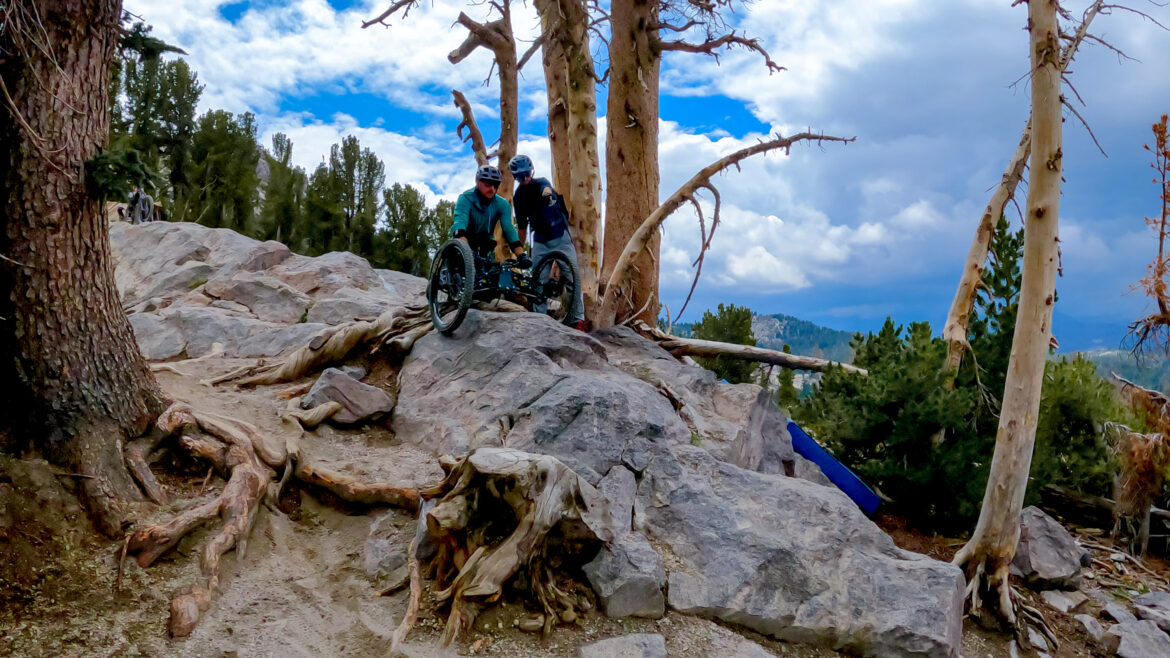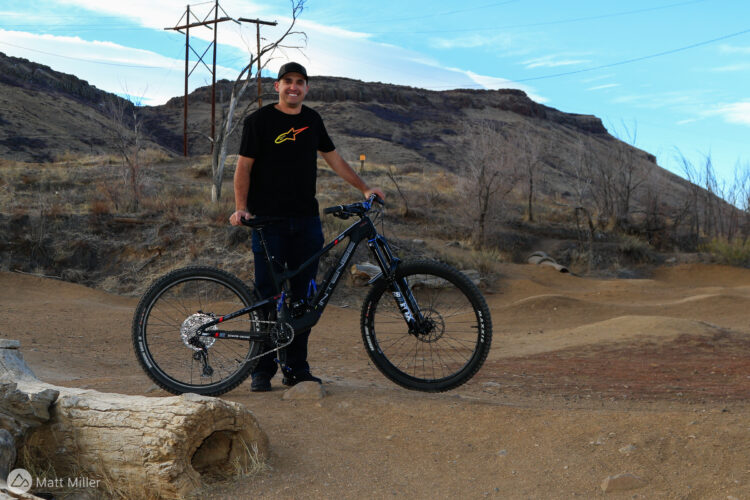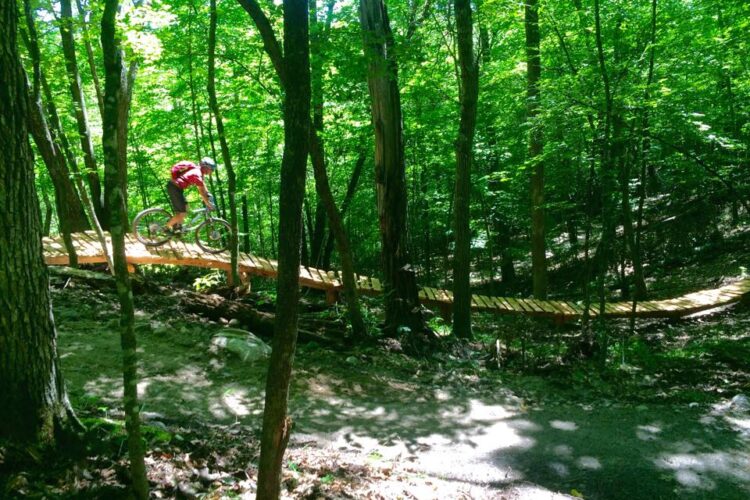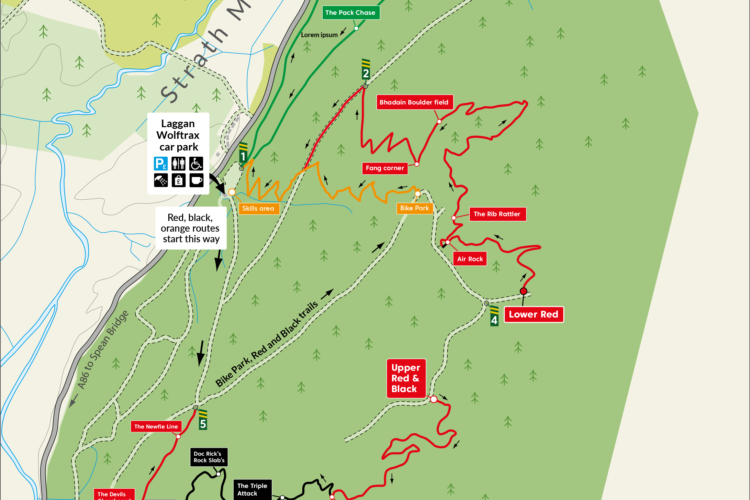
It’s no secret that trail centers around the globe are growing at an unprecedented rate, but so is the larger mountain bike community. We’re not just talking about the typical two-wheeled rider. From British Columbia to Vermont, more trails are being ridden by adaptive mountain bikers.
Inclusive bikes and trail design, as well as modified social environments, are opening doors to different user groups, thanks to a trio of adaptive nonprofits, athletes, and trail builders. So, what is adaptive mountain biking, how does it contribute to the trails we all ride, and how can we break down some of the barriers that prevent people from accessing the great outdoors?
What is adaptive MTB?
Adaptive mountain biking applies to a broad spectrum of people with disabilities and the mountain bike design changes to suit the needs of the rider. This can range from a blind person aboard the passenger seat of a tandem bike to a three-wheeled handcycle for a paraplegic.
Some upper limb amputees have routed both brakes through one lever on an otherwise unmodified bike. Single leg amputees can ride minus one crank arm or with a prosthetic, even jumping stair sets. It is difficult to categorize all the possible bikes here, as most are highly customized to meet the specific needs of an individual rider, but much like normal mountain bikes, there are higher and lower-end adaptive mountain bikes.
Jeremy McGhee, an adaptive rider who resides in Bentonville argues that adaptive bikes themselves offer some advantages.
“It’s kind of half 4x4ing,” he said. “There is so much suspension and with the electric power assist, you would be surprised what the adaptive bikes can motor through.”
How existing trails are being made more adaptive-friendly
The physical dimensions and dynamic motion of adaptive bikes change some of the considerations a trail builder has, but not as dramatically as some would expect. Most changes in trail design are quite simple, such as ensuring that bridges and other pinch points are wide enough to accommodate adaptive bikes. There are no universally accepted trail standards for aMTBs, but this is quickly evolving with two Canadian organizations offering guidance; Kootenay Adaptive Sports Association and Trail Holistics.
McGhee, also founder of The Unpavement, prefers the terms universal trail design or inclusive trails instead of adaptive trails. As a trail auditor himself, he helps identify the “low-hanging fruit” to find trails that would only need a few minor modifications to open up many more miles of trail for adaptive riders, but tries to keep them indistinguishable from other MTB trails.
“When I hear [adaptive trail], I hear segregation,” he said. “There’s a way to build trails that is exciting for everyone. It doesn’t take much. The other misconception is that making a trail adaptive-friendly is dumbing it down or sanitizing it. That’s not the case at all because there are multiple levels of adaptive riders.”
Though it can be a balancing act making a trail adaptive-friendly, McGhee says they often don’t need much.
“We build ride-arounds and tree gates,” he said. “Sometimes all you have to do is widen the line up [before a pinch point] so I can hit it at a 90 degree angle so I can get through it. We’ve even created ramps through trees… We never want to change the desired experience of a trail.”
Many existing easy to intermediate trails may already be aMTB-friendly with almost no modifications, as long as narrow points in the trail, turning radiuses, and off-camber areas are considered. Kingdom Trails in northern Vermont is keen on certifying certain trails within the network as aMTB-compatible. CJ Scott, Trails Director of Kingdom Trails, has been working with local adaptive riders and nonprofit organizations to expand adaptive mileage on the existing trail network.
“We were able to go and ride the trails and if [the adaptive athletes] could ride the trail with minimal to some assistance, we were able to check off each trail as we went down it,” said Scott. “Plus, we started to identify what trails were rideable, but needed a few adjustments here and there.”
Scott told us that the demand to create more aMTB trails has been brought on with a push for inclusivity through close coordination with Vermont Adaptive Ski and Sports and the Kelly Brush Foundation. In addition to more aMTB signage, maps are available at trail kiosks that are physically lower, therefore easier to reach for adaptive riders.
With this attitude and the fact that Kingdom Trails builds around five miles of new trail every year, the future for all types of riders is promising in northern Vermont. Kingdom Trails now counts around 53 miles of adaptive-friendly trail, including advanced terrain.
Building aMTB-specific trails

Trails built specifically for adaptive riders are becoming more common. Just this past June, over five miles of new purpose-built aMTB trails opened within the Sagamore Unit of Cuyuna State Park, Minnesota thanks to the work of local nonprofits, the state Department of Natural Resources, and Rock Solid Trail Contracting. Rock Solid is one of the largest trail building companies in the U.S. and they’ve also completed one of the largest aMTB-specific projects.
“Cuyuna was the biggest by far, purpose-built, adaptive MTB trails in recent memory,” said Kyle McGurk, the project manager for Rock Solid. “We really just started getting involved with adaptive MTB trails in the last two years as we’ve gained more demand.”
McGurk urged the importance of having accessible, beginner-level adaptive trails that are available for nonprofits to use to get more people on adaptive mountain bikes, like the Courage Kenny Rehabilitation Institute, which provided input on the Cuyuna project.
Having adaptive riders out during the building phase was vital. “We had them out twice during construction in structured feedback,” said McGurk. First, “at 10% completion and then later on so we were able to adjust based on earlier feedback.”
McGurk said they have plans for more aMTB trails, and like McGhee, he said the line between adaptive and traditional trails would be thinner. Recognizing and building aMTB trails feels more important than ever, said McGurk.
“Especially in the lens of public lands, it’s really important that, as we advocate for mountain biking, we’re not giving huge swaths of public land and giving it to only well-to-do, able-bodied people.”
Accessible trails are only the first barrier
Accessible trails, along with an accepting social environment, is vital to get more people cruising ribbons of trail. Many riders were not always disabled, such as McGhee. Mountain biking is a way for him to continue to trail run like he did before a motorcycle crash in 2001 left him with complete leg paralysis at age 25.
“I don’t consider myself a mountain biker,” he said. “My bike is how I trail run. That’s how I access my relationship with nature.”
One barrier for adaptive riders is the need for a ride partner. Even advanced riders like McGhee may only be able to ride a small percentage of a trail network solo, and that is if they have already ridden the trails with a partner and/or have been able to see a video preview of the entire trail.
“There is a clear defining line in the user group: riders with support and those without,” said McGhee.“If I can ride 20% of the trails in a trail network solo, I call that a huge win.”
The way trail data is available to riders is changing too, with popular trail apps adding aMTB filters. Some of them even include the delineation between support and no support. McGhee helps rate aMTB trails with more visual information for adaptive athletes, along with a blog. In an age where you can whip out your smartphone and quickly find a wealth of information about trails in your area, it is essential for aMTB riders to really evaluate the risks.
McGhee told us about one instance where he was caught in a flash flood on a solo ride, chest deep in water and had to slog through wet clay to get back to the trailhead.
“Imagine that: a paraplegic on the ground, turning this huge 7-foot-long bike on a really narrow trail,” he said. “Just a normal ride can go south really quick. I don’t have the luxury of walking my bike back to the trailhead.”
The costs of aMTBs are another barrier for riders. “It could be as low as $5,000 for a rigid gravel bike, to my bike with all the bells and whistles for $16,000,” said McGhee, who is also the distributor for Polish aMTB company Sport-on. The costs add up with the advanced mechanics and customization each bike has. “It takes one person a week to build one of these, all the small parts, all the small things that are welded. It’s a miracle that these bikes even exist,” he said.
For those looking to get into the sport, reaching out to a local nonprofit is often the best place to start. Nonprofits, such as Vermont Adaptive Ski and Sports, have a small fleet of bikes and work with everyone.
“We have eight adaptive bikes,” said the program manager, Felicia Fowler. “Financially, we don’t turn anyone away. We have a sliding scale scholarship. The past two years, we have had grants to provide free programming to kids under 18. We find grants to get people involved because we know how expensive having a disability and equipment is.”
Despite the challenges though, McGhee is optimistic. Technology keeps getting better and its impact is just as important.
“It’s going to get so good, there will be a lot less need for help making trails adaptive-friendly,” he said. “We’re helping people have a relationship with nature. It’s not just important, it’s vital. Exercising outdoors is a magical formula.”





















